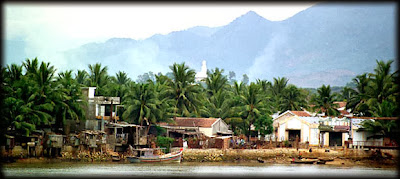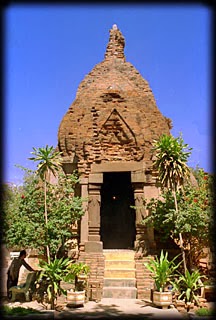 |
| NHATRANG |
The name Nha trang is a Vietnamese pronunciation of a Cham word Eatran or Yjatan. Ea or Yja means river, and tran means reed. According to the locals, there once were a lot of reeds along Ngoc Hoi river. The river winds its way through the town. Ngoc Hoi was later renamed Nha Trang river.
Another theory of the origin of Nha Trang's name has a more amusing twist. Long ago, in this part of the country, all the houses were made out of the reeds and mud gathered from Ngoc Hoi river. The only house that was made out of bricks were the house belonging to Dr. Yersin, a French immunologist who made his home here. The house itself was painted prominently white and could be seen by vessels coming from far away. Once there was a foreign vessel passing by. The captain asked his translator where he was. The translator not knowing where they were blurted out Nha` tra('ng or white house in Vietnamese. The captain duly noted on his chart Nha Trang. Because most foreign languages do not make use of tones, the captain's name for this part of the country stuck.
From Saigon going northeast on highway 1 to Nha Trang, the road is extremely bouncy. The trip will take between 9-10 hours. On the way, the two major cities are Phan Rang and Phan Thiet. Both cities are small in size, however, Phan Thiet is very famous for its nuoc mam - fish sauce industry.
The next famous site before reaching Nha Trang is Cana beach. This stretch of beautiful white sand is a beautiful beach with a few restaurants; it is a popular rest area for travellers coming from the South.
There are many Thanh Long (Green Dragon fruit) orchards along the highway leading to Nha-Trang. This fruit is known to grow only in this region and has become popular only in recent years.
 |
| Nha Trang City Beach |
Upon arriving to Nha Trang, most tourists will pass through downtown. Beyond the rows of businesses and homes will be Nha Trang beach. Tran Phu Boulevard is Nha Trang most famous thoroughfare. It runs the length of the beach with several major hotels located within a few steps from the beach. Unlike most major city in Vietnam where the primary mode of transportation is the motorbike, many people of Nha Trang still walk or use the bicycle as their means of getting around.
This adds to the tranquillity of the town. There is very little pollution or noise from motor vehicles.
On any given day, between 5:00 am to 8:00 am Nha Trang beach is filled with local people taking in the fresh sea breeze, socializ ing, playing soccer, badminton or practicing Tai chi. Most people in Nha Trang fear being darken by the sun. For this reason, the window between 5-8 am (where sunlight is less intense) is peaked with activities. Another reason is that many go to the ocean
for a morning swim, to exercise and to listen to daily news (from the many conspicuously placed loud speakers on electrical poles). In Nha Trang, going to the beach is a family affair. One often see generations of families going to the beach together. However, by 8:00 am the beach is magically emptied of all the hustle and bustle of earlier activities to once again return to silence and serenity.
 |
| The Po Nagar |
One tower is the shrine to Xiva, one of three most powerful deities in Hinduism. One tower is dedicated to Ganexa, the son of Xiva. This deity has a human body and an elephant head. Po Nagar is the tallest tower, also known as Thap Ba (Tower of the Lady). Po Nagar or Uma is the wife of Xiva the supreme. Po Nagar towers stands 23m in height and was built around 817. Bricks were used in the building of Po Nagar. The four-sided structure is topped by a pyramid with a statue of the four armed Xiva riding Nandin the enchanted ox at the apex. The exterior of the tower is covered by intricate rock carvings of dancers, people rowing boats, grinding rice or hunting with bows and arrows
The interior is airy and cool. An alter made of granite is placed at the base of the statue of Po Nagar. Po Nagar is a goddess with ten arms. She is also the goddess credited for her help with teaching people how to farm. Her statue was originally made out of hard incense wood. The statue was removed by the French in 1946. A new statue with more Vietnamese features is its replacement. The Po Nagar towers complex is an example of Chams architecture and art at its height







